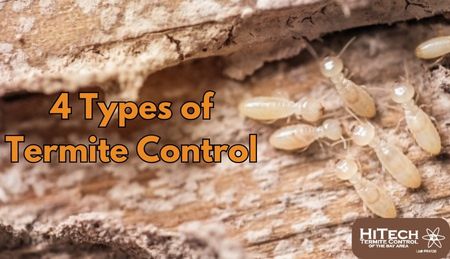4 Major Types of Termite Control
 If we have to find some words to describe the effect of termites on a property, our top choices would be destructive and relentless. Without proper termite control measures, the termites can cause several hundred or even thousands of dollars worths of damage to the homeowner.
If we have to find some words to describe the effect of termites on a property, our top choices would be destructive and relentless. Without proper termite control measures, the termites can cause several hundred or even thousands of dollars worths of damage to the homeowner.
If you notice any signs of termite activity on your property, then you should contact a professional termite control company immediately. The termite inspector sent by the company will inspect the property and confirm the termite infestation. Later, after evaluating the types of termites and the extent of termite infestation on the property, he will suggest a suitable treatment that can control the termites.
To protect your property, it is crucial to understand the different types of termite control methods. In this blog, we will discuss the four major types of termite treatments along with the advantages and limitations of each approach.
Liquid Termite Treatment
This is the most commonly used method of termite control. This method is greatly effective against subterranean termites.
The subterranean termites live underground and thus enter the house through the places where there is soil contact. Again, they need to go back to their nests underground since they are in constant need of moisture.
With liquid treatment, specially developed termiticides are diluted in water and applied to the soil directly under or around the foundation. When the termites try to tunnel into the property, they need to pass through the treated soil. The termiticides in the soil will kill the termites.
If the termite damage is extensive and there are too many possible entry points, then a trench is dug around the property and liquid termiticide is applied to the soil before the trench is filled again. Thus, a secure perimeter is established around the property.
Advantages of Liquid Termite Treatment
- Long-lasting effects - effective treatment barriers can last for 5-10 years.
- The best treatment to keep away subterranean termites.
- It does not need constant maintenance.
- Can be used for both preconstruction and postconstruction termite control.
Limitations of Liquid Termite Treatment
- Can become expensive for larger properties.
- Only the termites that come in contact with the treated soil will be eliminated.
- The treated soil should be replaced as required to keep the barrier effective.
Also Read: Are Older Homes at a Higher Risk of Termite Infestation?
Termite Baiting
This is another termite control method effective against subterranean termites. Here, instead of digging a trench around the property, holes are drilled in the ground around the property and baits are placed in these holes.
The baits contain cellulose mixed with termiticides. The subterranean termites get attracted to the cellulose in the baits and eat them. The termiticides in the baits are slow-acting and hence the termites don’t immediately die. They go to their nests and share the termiticides with the other termites in the nest. Eventually, the whole termite colony is poisoned and eliminated.
Advantages of Termite Baiting
- Has the possibility of eliminating the whole colony of termites.
- Long-term preventive control.
Limitations of Termite Baiting
- Takes longer to affect the termites.
- Needs regular monitoring.
- Baits need to be replaced.
- Often recommended to be used with liquid termite treatments.
Fumigation Termite Control
Fumigation is recommended for properties with a severe drywood termite infestation. Unlike subterranean termites, drywood termites do not require moisture and hence will just live in the wood they eat. Thus, liquid termite treatments and baiting treatments do not help against drywood termite infestations.
Fumigation involves erecting a tent-like air-tight structure around the property to be treated. Then, a gas that is toxic to the termites is injected into the tent so that it reaches even the most remote parts of the structure. The gas causes the termites to die thus effectively eliminating the drywood termite infestation in the house.
Advantages of Fumigation Termite Control
- It is the most effective result-oriented termite control method against drywood termites.
- Can even help with eliminating a severe drywood termite infestation.
Limitations of Fumigation Termite Control
- The process can take anywhere between 24-72 hours and this duration varies with the size of the property and the severity of infestation.
- The people, plants and animals on the property should find alternate accommodation until the treatment is fully complete.
- The method can be expensive.
- The property needs to be prepared before fumigation and cleaned after the treatment.
- Does not offer long-term protection from future infestations.
Also Read: What Happens When You Leave a Termite Infestation Untreated?
Microwave Termite Control
This method uses heat energy to eradicate the termites. The heat is directed at the termites which causes them to lose moisture and die. The microwave termite control method is most effective against drywood termite infestations that are confined to specific places.
Advantages of Microwave Termite Control
- There is no usage of toxic gases or chemicals.
- Effective for eliminating small and confined infestations.
- Cheaper when compared to fumigation.
Limitations of Microwave Termite Control
- Not effective against severe drywood and subterranean infestations.
HiTech Termite Control
Safeguarding your property against termites requires help from an expert. Contact HiTech Termite Control for professional guidance and effective solutions. Don’t let these little pests compromise one of your biggest investments. Check out the services we offer here.
- Oct 09, 2023
